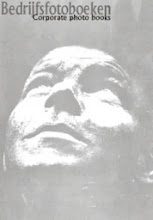 Onbekende fabriek Kaarsen van de band pakken en lonten op maat knippen.fotograaf: J.D. Filarski, 1919
Onbekende fabriek Kaarsen van de band pakken en lonten op maat knippen.fotograaf: J.D. Filarski, 1919Dutch Factory Girls Photos from the collection of the National Archive
13 September to 23 November 2008
13 September to 23 November 2008
 Kunsthal Rotterdam presents a selection of those pictures that can be considered most extraordinary from a total of over 4000 photographs of Labour Inspection that are in the collection of the National Archives. The photographs, in black and white, have been taken by members of Labour Inspection between 1900 and 1950 in order to shed light on the poor working conditions, child labour, unsafe situations and occupational diseases. The pictures, showing workmen at machines, young girls in factories and home workers, are taken out of the archives for the very first time in over ninety years. Special attention is paid to the close-ups by Inspector Filarski, which form a clear exception to the more business like registrations made by his colleagues. Together, these photographs provide a realistic portrait of working conditions and branches of industry in the recent past.
Kunsthal Rotterdam presents a selection of those pictures that can be considered most extraordinary from a total of over 4000 photographs of Labour Inspection that are in the collection of the National Archives. The photographs, in black and white, have been taken by members of Labour Inspection between 1900 and 1950 in order to shed light on the poor working conditions, child labour, unsafe situations and occupational diseases. The pictures, showing workmen at machines, young girls in factories and home workers, are taken out of the archives for the very first time in over ninety years. Special attention is paid to the close-ups by Inspector Filarski, which form a clear exception to the more business like registrations made by his colleagues. Together, these photographs provide a realistic portrait of working conditions and branches of industry in the recent past.Labour Inspection
At the end of the nineteenth century child labour still occurred regularly in the Netherlands, despite the famous Kinderwetje, a law imposing an end to child labour constituted by Van Houten (1874). To put an end to the evasion of the Kinderwet, extreme working hours and unsafe machine environments, Labour Inspection was established in 1890. It was the first independent service which visited factories and home workers, as well as outdoor workers, in order to check the age of labourers and inspect working conditions, safety and hygiene. From 1900 onwards it became customary to accompany the written reports by the inspectors with photographs. Once photographed, after all, the wrongs and consequences of accidents occurring at the work floor could no longer be easily denied. The purely business like registrations made by the inspectors were used as examples, proof or warnings and showed working life in the Netherlands in the first half of the twentieth century in a down to earth yet impressive manner.
At the end of the nineteenth century child labour still occurred regularly in the Netherlands, despite the famous Kinderwetje, a law imposing an end to child labour constituted by Van Houten (1874). To put an end to the evasion of the Kinderwet, extreme working hours and unsafe machine environments, Labour Inspection was established in 1890. It was the first independent service which visited factories and home workers, as well as outdoor workers, in order to check the age of labourers and inspect working conditions, safety and hygiene. From 1900 onwards it became customary to accompany the written reports by the inspectors with photographs. Once photographed, after all, the wrongs and consequences of accidents occurring at the work floor could no longer be easily denied. The purely business like registrations made by the inspectors were used as examples, proof or warnings and showed working life in the Netherlands in the first half of the twentieth century in a down to earth yet impressive manner.
Inspector Filarski
Jan Daniël Filarski (1884 -1969) joined Labour Inspection in 1916. He was a technical servant at the service, who dedicated himself to enhancing safety whenever and wherever people were working with machines. At the exhibition special attention is paid to the sober pictures by inspector Filarski that, taken with great empathy and eye for detail, form a pleasant exception to the more objective registrations of factories filled with young girls working at the assembly line, as taken by his colleagues. In careful compositions and with a low camera position he managed to capture the working conditions in the factories from extreme close-up. Filarski's in-company coverages are deliberately somewhat unclear, as a result of which they obtain a nostalgical character in which time has somehow been put to a standstill.
Jan Daniël Filarski (1884 -1969) joined Labour Inspection in 1916. He was a technical servant at the service, who dedicated himself to enhancing safety whenever and wherever people were working with machines. At the exhibition special attention is paid to the sober pictures by inspector Filarski that, taken with great empathy and eye for detail, form a pleasant exception to the more objective registrations of factories filled with young girls working at the assembly line, as taken by his colleagues. In careful compositions and with a low camera position he managed to capture the working conditions in the factories from extreme close-up. Filarski's in-company coverages are deliberately somewhat unclear, as a result of which they obtain a nostalgical character in which time has somehow been put to a standstill.
Publication
At Waanders publishers will appear the Dutch book 'Meisjes van de Fabriek', ISBN 90 400 8538 3. See for a slideshow ...
At Waanders publishers will appear the Dutch book 'Meisjes van de Fabriek', ISBN 90 400 8538 3. See for a slideshow ...
 see for a complete slideshow on Flickr ...
see for a complete slideshow on Flickr ... Tricotweverij, VriezenveenKnippen van ondergoed.fotograaf: J.D. Filarski, 1919
Tricotweverij, VriezenveenKnippen van ondergoed.fotograaf: J.D. Filarski, 1919 Glasfabriek v/h Meursing & Co, Nieuw Buinenfotograaf onbekend, 1919
Glasfabriek v/h Meursing & Co, Nieuw Buinenfotograaf onbekend, 1919 Huisarbeid, garnalenpellen, Harderwijkfotograaf onbekend, 1919
Huisarbeid, garnalenpellen, Harderwijkfotograaf onbekend, 1919













Geen opmerkingen:
Een reactie posten